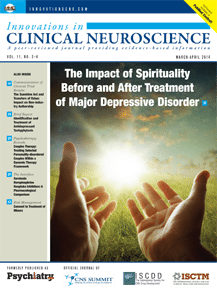Welcome to the March–April issue of Innovations in Clinical Neuroscience. In this issue, we are pleased to introduce a new commentary series on the communication of clinical trial results by Dr. Leslie Citrome. In this month’s installment titled, “The Sunshine Act and Transfers of Value: Impact on Non-industry Authorship,” Dr. Citrome discusses the use of outside editorial assistance for the preparation and publication of industry-sponsored journal articles by United States-based physician-authors and how this might be impacted under the United States Physician Payments Sunshine Act.
Next, Peselow et al present their original research article, “The Impact of Spirituality Before and After Treatment of Major Depressive Disorder.” In the study, the authors sought to assess spirituality in depressed patients and evaluate whether the degree of initial depressive symptoms and response to pharmacotherapy treatment had a correlation with degree of spirituality and belief in God. The authors found that greater spirituality was associated with less severe depression and the degree to which the measures of depressive symptom severity, hopelessness, and cognitive distortions improved over the course of eight weeks was significantly greater for those patients who were more spiritual.
Following this, Dr. Steve Targum provides us with a brief review titled, “Identification and Treatment of Antidepressant Tachyphylaxis.” Dr. Targum describes antidepressant tachyphylaxis and discusses potential causes of this condition as part of a comprehensive treatment planning process.
Next, Landucci and Foley provide us with this month’s Psychotherapy Rounds article titled, “Couples Therapy: Treating Selected Personality-disordered Couples Within a Dynamic Therapy Framework.” The authors discuss the unique challenges therapists face when a personality-disordered couple presents for couples therapy. According to the authors, the literature typically describes couples therapy as situation-based (how to treat couples dealing with divorce, an affair, illness); however, in the personality-disordered couple, the dysfunction is not the product of a crisis, but rather a long-standing pattern that has escalated to the level of crisis. The authors present practical techniques, modeled in case vignettes, that can be applied directly to couples therapy with the unique characteristics of personality-disordered couples in mind.
Following this, Sansone and Sansone provide us with this month’s The Interface article titled “Serotonin Norepinephrine Reuptake Inhibitors: A Pharmacological Comparison.” Here the authors review the available serotonin norepinephrine reuptake inhibitors in the United States and include information on indications for use, chemical structure, pharmacological properties, generic availability, half-life, metabolism and excretion, presence or not of active metabolites, dosing schedules, proportionate effects on serotonin and norepinephrine, and the timing of serotonin and norepinephrine.
Finally, in the Risk Management column, “Consent to Treatment of Minors,” Ann McNary, JD, reviews issues surrounding consent to treat minors whose legal guardians may or may not be present during treatment.
We hope you enjoy the issue. As always, we welcome your comments and your submissions.
Sincerely,
Amir Kalali, MD
Editor, Innovations in Clinical Neuroscience






